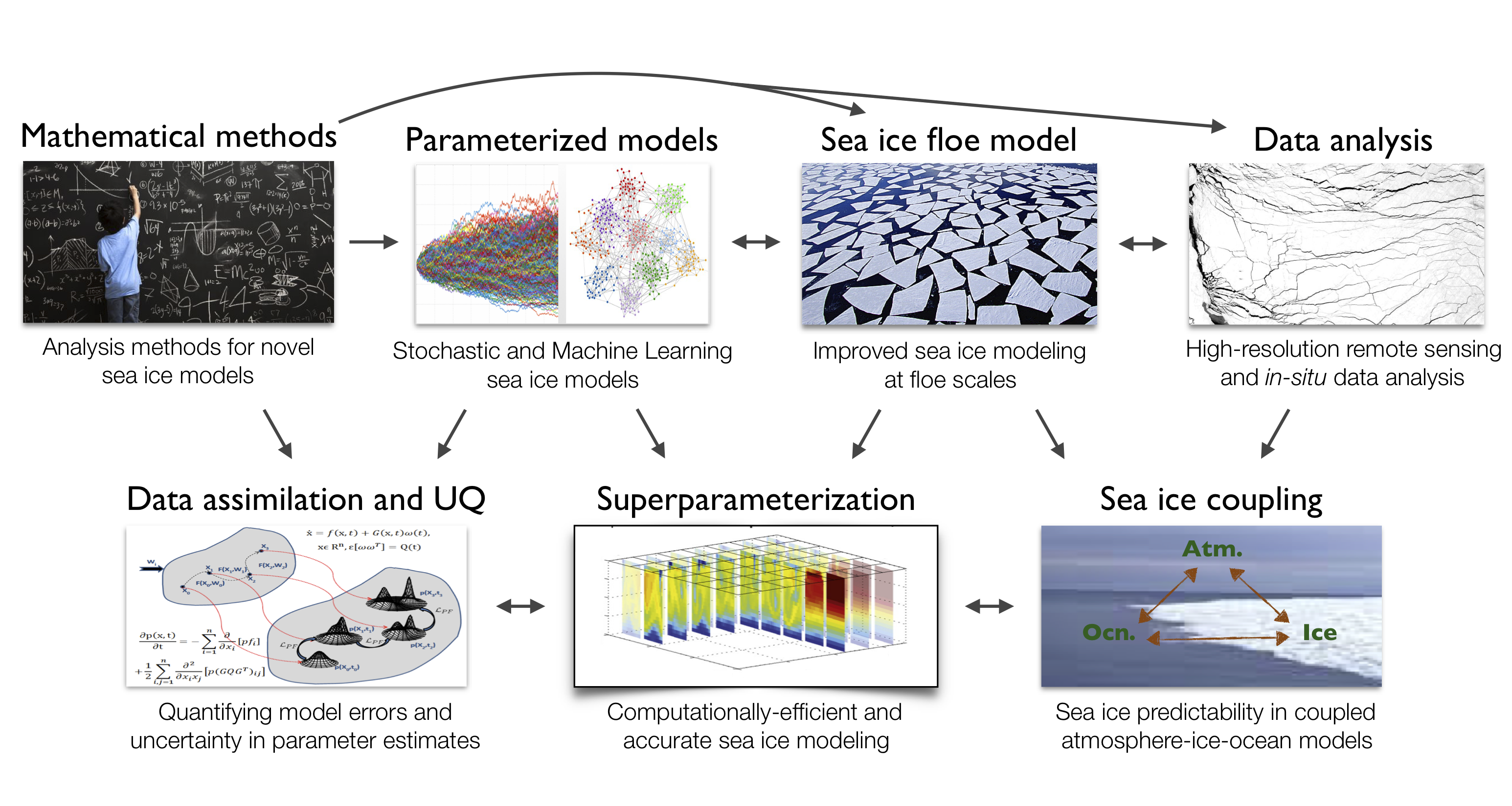
Mathematics and Data Science for Improved Physical Modeling and Prediction of Sea Ice
Sea ice dynamics is a topic of continuing debate, particularly at scales of motion that are comparable to sea ice floes. SubZero is a conceptually new sea ice model developed from scratch that is based on an explicit representation of the floe lifecycle. The goal is to have a model that could bridge the gap between the floe scale and the basic scale sea ice dynamics. The conceptually new goal for SubZero is to have a sea ice model geared to explicitly simulate the lifecycles of individual floes by using complex discrete elements with time-evolving shapes. This unique model parameterizes floe-scale processes, such as collisions, fractures, ridging, and welding, to bypass resolving intra-floe bonded elements.
My newest project focuses on enhancing our understanding of seasonal sea ice breakup through detailed simulations at the floe scale. At the core of this initiative is the SubZero model that will help analyze wind-driven ice breakup in confined areas, such as Kobuk Lake in Alaska. The motivation for this project arises from the urgent need to address the dynamic ice patterns that pose risks to subsistence activities in Kotzebue. Traditional sea ice models often fail to simulate essential fractures and floe dynamics accurately, and SubZero aims to fill these gaps in floe-scale sea ice modeling by effectively incorporating diverse data sources to improve predictions. Ultimately, by enhancing the accuracy of sea ice forecasts, this project aims to increase safety and support the subsistence lifestyles of communities around Kotzebue Sound, enabling them to better prepare for the challenges posed by a changing climate.
Collaborators: Georgy Manucharyan, Andy Thompson, Sam Stechmann, and Dimitris Giannakis
My research at the University of New Hampshire involved systematically exploiting the tendency of turbulent wall flows to self-organize into “structures” [1]. These structures are important because they are relevant to turbulent transport. This allowed me to derive a reduced set of equations from the full NS equations. The key idea was to leverage a technique from applied mathematics known as asymptotic analysis to derive simplified versions of the NS equations that govern the flow regions within the boundary layers where the self-organizing structures form [2]. This reduction is possible because only a simpler subset of the physical processes (e.g., forces) are significant in distinct flow regions in the physically relevant asymptotic limit under consideration. The multi-scale nature of our self-sustaining process (or feedback loop) is a unique feature not found in existing theories. The flow proposal has a three-layer matched asymptotic structure, in which two of the subdomains have disparate length scales. This leads to a WKBJ decomposition, which is just one of the nontrivial differences between my dissertation research and the existing self-sustaining process theories present in the literature. Notably, this research has culminated in identifying an entirely new self-sustaining process that is operative over the majority of the flow domain in wall turbulence and can help explain the origin of a dominant structure.
One crucial aspect of the reduced equations is their quasilinear mathematical structure. We numerically benefited from the quasilinear computational efficiency without artificially suppressing physics in this framework when numerically solving the reduced equations. My research also includes an extension of the quasilinear algorithm known as generalized quasilinear (GQL) which was implemented to understand how these nonlinear interactions help describe the underlying fundamental physics. Physically, the quasilinear approximation corresponds to the suppression of specific mode interactions in the turbulent dynamics. The results show that even a modest number of low-frequency modes produces considerably more accurate results than a quasilinear approximation using Direct Numerical Simulation (DNS) as the baseline. Plane Poiseuille flow describes a flow between two long plates driven by a constant pressure gradient which allows for simplifications to the Navier-Stokes equations. Applying the GQL approximation to Poiseuille flow demonstrates that a slight increase in the number of nonlinear interactions can significantly increase the model’s accuracy. To investigate this, our research group has utilized Dedalus. Dedalus works by reading a nearly arbitrary system of differential equations in plain text entered by the user and splits the terms into sets of matrices and arithmetic trees to be solved efficiently by the program.
Collaborators: Greg Chini, Joe Klewicki, and Chris White